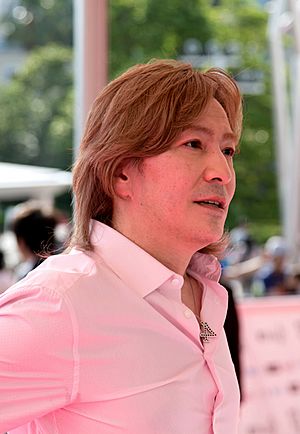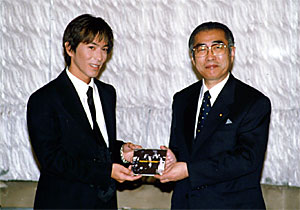Tetsuya Komuro facts for kids
Quick facts for kids
Tetsuya Komuro
|
|
|---|---|

Komuro in 2014
|
|
| Background information | |
| Also known as | "TK" |
| Born | November 27, 1958 Fuchū, Tokyo, Japan |
| Died | Error: Need valid death date (first date): year, month, day |
| Genres | |
| Occupation(s) |
|
| Instruments | Keyboards |
| Years active | 1975–2018, 2020–present |
| Labels |
|
Tetsuya Komuro (小室 哲哉, Komuro Tetsuya, born November 27, 1958) is a famous Japanese musician, songwriter, and record producer. He is known for being one of the most successful producers in Japanese music history. He helped bring modern electronic dance music to a wide audience in Japan.
At one point in April 1996, he wrote and produced all of the top 5 songs on Japan's Oricon singles chart, which was a world record! In 1995, he also set a record in Japan by having the top 3 spots in music copyright rankings. Many artists he worked with were called the "TK Family." This group included popular singers like Namie Amuro, hitomi, TRF, Tomomi Kahara, and Ami Suzuki. By 2008, the music he produced had sold over 170 million copies, mostly in Japan. He has also written over 42 million copies of singles, making him one of Japan's top lyricists.
Contents
Music Journey
Starting Out: 1979–1994
Tetsuya Komuro began his music career in 1979 as a keyboard player for a band called Speedway. In 1984, he formed his own band, TM Network, with Takashi Utsunomiya and Naoto Kine.
A year later, in 1985, Komuro released his first solo music. It was the soundtrack for the anime movie Vampire Hunter D. His band, TM Network, also performed the closing song for the movie, "Your Song." He later composed music for other films like Heaven and Earth and Seven Days War.
As a solo singer, Komuro released hit singles such as "Running to Horizon" and "Gravity of Love" in 1989. Both songs reached the top of the Oricon music charts. He also worked with American musician Warren Cuccurullo in 1989 and 1990.
Komuro also wrote songs for other artists. He composed "My Revolution" for Misato Watanabe, which won a major award at the 28th Japan Record Awards in 1986. TM Network's single "The Point of Lovers' Night" also topped the Oricon charts in 1990.
In 1990, TM Network changed its name to TMN. Komuro also teamed up with X Japan's drummer and pianist Yoshiki to form a duo called V2 in 1991. TMN eventually disbanded in 1994.
Becoming a Top Producer: 1994–1997
By the early 1990s, Komuro spent a lot of his time writing and producing songs for many other musicians. He was a pioneer in bringing dance music to Japan. He became very famous in the 1990s for producing many hit songs for artists like TRF, Tomomi Kahala, Namie Amuro, Ami Suzuki, hitomi, Ryoko Shinohara, and H Jungle with t.
In 1994, he created the music for the Japanese anime film Street Fighter II: The Animated Movie, which was based on the popular video game. Ryōko Shinohara sang the theme song for the movie, "Itoshisa to Setsunasa to Kokoro Zuyosa to", with Tetsuya Komuro. This song was a huge hit, selling over two million copies.
Komuro was often helped by mix engineers like Pete Hammond and Dave Ford. He is also credited with helping Daisuke Asakura, another popular Japanese composer, become famous. Asakura started as a backup keyboardist for TM Network and considers Komuro his "teacher."
In 1997, Komuro started working on music outside of Japan. He remixed the theme music for the American film Speed 2: Cruise Control.
Later Career: 1998–2007

Tetsuya Komuro also released his own albums and was part of bands like Globe, Kiss Destination, and Gaball. In 1998, Globe's song "Wanna Be A Dreammaker" won a major award at the 40th Japan Record Awards. In 1999, Komuro, Utsunomiya, and Kine got back together as TM Network, and they are still active today.
From 1998 to 2001, Komuro worked with French keyboardist Jean Michel Jarre. They wrote the theme song for the 1998 FIFA World Cup, "Together Now", and other songs. They even performed a concert together in Okinawa on January 1, 2001.
Return to Music: 2009–Present
After a break, Komuro made a surprise appearance at the Avex Group Holdings' concert tour a-nation 2009 in August 2009. He played a medley of his hit songs on the piano and reunited on stage with his bandmates from Globe, Marc Panther and Keiko Yamada.
Komuro continued to compose music for other artists. He composed AAA's hit single "Aitai Riyū/Dream After Dream (Yume Kara Sameta Yume)", released in May 2010. He also composed many songs for Japanese pop star Ayumi Hamasaki, including her 2010 album Love Songs and the 2013 single "Feel The Love."
In July 2017, he formed a duo called Pandora with Daisuke Asakura. They produced the song "Be the One" with Beverly, which was used in the TV drama Kamen Rider Build.
In January 2018, Komuro announced he would step away from the music industry. However, in July 2020, he returned to producing singles for Ayumi Hamasaki and Nogizaka46.
In October 2021, Tetsuya Komuro officially announced his full-time return to music with the reformation of TM Network. Pandora also reformed in January 2025.
Music Releases
Studio Albums
- Digitalian is Eating Breakfast (1989)
- Psychic Entertainment Sound (with Mr. Maric, 1990)
- Hit Factory (1992)
- Piano Voice: TK Piano Works (2003)
- Far Eastern Wind – Winter (2008)
- Far Eastern Wind – Spring (2008)
- Far Eastern Wind – Summer (2008)
- Far Eastern Wind – Autumn (2008)
- Digitalian is Eating Breakfast 2 (2011)
- Digitalian is Eating Breakfast 3 (2013)
- EDM Tokyo (2014)
- Jobs #1 (2017)
- Jazzy Token (2022)
Live Albums
- Tetsuya Komuro Jungle Massive (1995)
- TK-Trap (1996)
- Synthesized Trance Vol. 1 (2002)
- Synthesized Trance Vol. 2 (2003)
Compilation Albums
- Saga: Tetsuya Komuro Classic Selection (1992)
- TK Million Works (1996)
- Arigato 30 Million Copies: Best of TK Works (2000)
- TK Works Super Tune: Best Selections (2003)
- Piano Globe: Globe Piano Collection (2003)
- Piano Wind: TK Ambient Selection (2003)
- The Greatest Hits: S (2006)
- The Greatest Hits: A (2006)
- TK Instrumental Works Selection 1986–2003 (2006)
- Komuro Tetsuya Meets Vocaloid (2012)
Remix Albums
- Blue Fantasy – Love & Chill Out With Trance Remixes (2002)
- Cream of J-Pop (2007)
- Digitalian is Remixing (2012)
- DEBF EDM 2013 Summer (2013)
Soundtracks
- Vampire Hunter D (1985)
- Seven Days' War (1988)
- Heaven and Earth (1990)
- Mademoiselle Mozart (1991)
- Hatachi no Yakusoku (1992)
- Street Fighter II: The Animated Movie (1994)
- Hitori ni Shinaide (1995)
- Private Actress (1998)
- Baober in Love (2004)
- Zoids: Fuzors (2005)
- Punchline (2015)
- Sunny: Tsuyoi Kimochi Tsuyoi Ai (2018)
Box Sets
- TK 1998 (1998)
- TK Box: Tetsuya Komuro Hit History (2011)
- Far Eastern Wind -Complete- (2012)
- Tetsuya Komuro Archives (2018)
- Tetsuya Komuro Archives Professional Products (2019)
Singles
- "Running to Horizon" (1989)
- "Gravity of Love" (1989)
- "Christmas Chorus" (1989)
- "Heaven and Earth" (1990)
- "Eien to Nazukete Daydream" (1991)
- "Haitoku no Hitomi ~Eyes of Venus~" (as V2, 1992)
- "Magic" (1992)
- "Pure (Hyper Mix)" (1992)
- "Silent Lover" (with C+C Music Factory, 1995)
- "Speed TK Re-Mix" (1997)
- "Call Me Anytime" (with Y.U.M, 2000)
- "Blue Fantasy – Love & Chill Out" (2001)
- "Speed TK Re-Mix: Hono no Koma" (2001)
- "Embryo" (with Lifecell, 2003)
- "Someday MF Remix" (2006)
- "If You Like It or Not" (2006)
- "@Buddha Bar" (2006)
- "Someday 2006" (2006)
- "Arashiyama" (2006)
- "I Want You Back (MF247 Remix)" (2006)
- "Angelina (MF Prepromix)" (2006)
- "Guts Daze!! (DJ TK Mix)" (2007)
- "Now 1" (2013)
- "Nijūniseiki e no Kakehashi" (with Kenichi Maeyamada, 2013)
- "Freedom (Remode)/Love Again (Remode)" (2015)
- "#Run" (feat. Sayaka Kanda & Tofubeats, 2015)
- "Have Dreams!" (with Tsunku feat. May J., 2016)
- "A New Lease on Life" (2016)
- "Blue Ocean" (2016)
- "Get Wild 2017 TK Remix" (2017)
- "Guardian" (feat. Beverly, 2018)
- "Running to Horizon (206 Mix)" (2021)
- "Trust On Me -Theme of E.T.E-" (feat. Maria, 2022)
See also
 In Spanish: Tetsuya Komuro para niños
In Spanish: Tetsuya Komuro para niños

